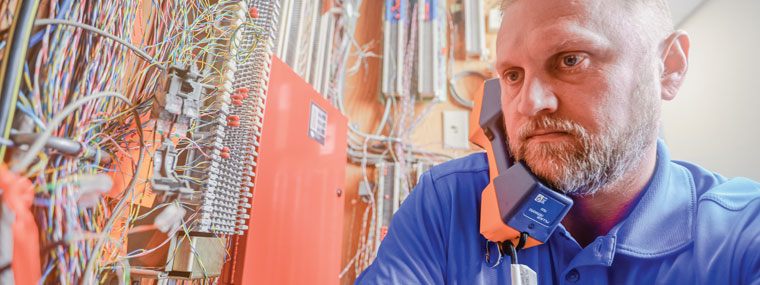
How Your Life Safety Devices Are Impacted by Landline Technology Phaseout
By Jennifer Burks / Published October 2022

Have you ever played the telephone game? You know, it’s where you sit in a circle and one person starts by whispering something in their neighbor’s ear, and by the time the message gets around to the last person in the circle, it doesn’t really resemble the original? That’s kind of what’s happening in the telecom industry with FCC Order 10-72a1 (link: go.kingsiii.com/FCC-Order). In my world, there’s been a lot of chatter about the “FCC mandate” and how it is impacting copper/analog/plain old telephone service (POTS) phone lines. It’s interesting what information people hold on to (and what they don’t), so let’s talk about what the FCC actually said.
FCC 10-72a1: What it really means
In August 2019, the FCC issued an order removing the burden of complying with two regulations passed in 1996 and allowed certain telecom companies the opportunity to no longer service traditional phone lines. So, while there was no actual “you have to stop servicing POTS lines” decree, there is an impact to those using copper lines. One of the most immediate, since telecom companies are no longer maintaining the lines, is deteriorating service. The second would be significantly higher phone line costs. In fact, we’ve seen up to $1,200 on California customers’ phone bills. And then, of course, there’s always the (highly likely) possibility that one day your phone could just stop working altogether. So, while not a mandate, landline replacement is very much a timely issue warranting your attention, with special care given to your emergency phone lines.
What’s next for your emergency phones?
So, what are the best options since now more than ever we need reliable communication? Voiceover Internet Protocol (VoIP) is the most common option we hear discussed. The cost efficiency of going with VoIP makes sense for buildings nationwide but carries serious risks for emergency phones. VoIP uses the internet as your regular phone service. Services that depend on managed strong internet connections to keep emergency phones live are unreliable. Customers risk losing communications during power outages or internet disruptions—two common scenarios. Additionally, placing emergency phones on VoIP networks in publicly accessible locations like elevators opens the door to a building’s network.
Also important: when it comes to emergency communications, VoIP is not usually code compliant. Issues like caller identification, being able to call back into an elevator cab, and battery backup cause most VoIP systems to fail emergency elevator phone inspection. And that’s not to mention, most IT teams aren’t in favor of others having access to their internal network.
Cellular as a solution
While other internet-based services simply aren’t dependable, these code requirements are in perfect harmony and are efficiently managed with cellular LTE solutions for your emergency devices. We’ve all become so dependent on that little mobile device we carry in our pocket, and that same cellular technology is a perfect solution for emergency communication, especially in your elevator. Not only does it leverage the mobile network, but it is also a completely code-compliant solution for both the International Building Code (IBC) and the American Society of Mechanical Engineers (ASME).
Items you should consider when switching your emergency phones to cellular
All cellular emergency phone solutions are not created equal. There is more to it than replacing those lines. Many of the cellular solutions readily available in the marketplace are designed for personal use but often make their way into commercial spaces as properties seek additional ways to make money. While on the surface these solutions appear adequate, they pre-sent several concerns when it comes to codes and safety. Those concerned with an efficient response to emergency phone calls using cellular phones need to be aware that the lack of regulation regarding cellular communicators within the elevator industry has led to low-quality, non-code compliant devices. When seeking out POTS replacement, you need a commercial-strength solution specifically designed for emergency use if you want a reliable response for any emergency call placed from your emergency device.
When choosing a landline replacement for your life safety devices, use this link to find what we consider to be the minimum standards for effective emergency phone monitoring as it relates to code compliance as well as performance and safety: go.kingsiii.com/minimum-standards-cellular. Most importantly —when it comes to ensuring you have a code compliant landline replacement option for your emergency devices–a good rule of thumb with your vendors is to trust but verify. While your vendor should be trusted to be the expert, you should also be sure that you are looking to your appropriate local jurisdiction to verify that your solution meets code.
Jennifer Burks
Marketing Director, Kings III Emergency Communications
Jennifer Burks serves as marketing director at Kings III Emergency Communications, where she works closely with both external experts as well as our in-house elevator code board members and qualified elevator inspectors in order to help educate the industry on important life safety topics regarding code compliance, telephony, and priority emergency access. She manages nationwide association engagement opportunities through national and regional trade shows, conferences, local events, and webinars through which she collaborates with many faces in the industry in an effort to discover their needs and meet their concerns.
For over 30 years, Kings III has provided complete, compliant, and affordable emergency phone solutions for elevators, poolside, stairwells, parking areas, and more. Our all-inclusive turnkey solution includes equipment, installation, maintenance, and 24/7 monitoring at our very own emergency dispatch center. We currently monitor 80,000+ emergency phones in North America.
The Kings III cellular solution completely eliminates dependency on analog lines by leveraging the nationwide VoLTE mobile network. This provides a reliable, code-compliant, and cost-effective solution for your emergency phones. Learn more about replacing landlines for your life safety devices at go.kingsiii.com/replace-landlines, call (866) 871-5633, or visit www.kingsiii.com.




